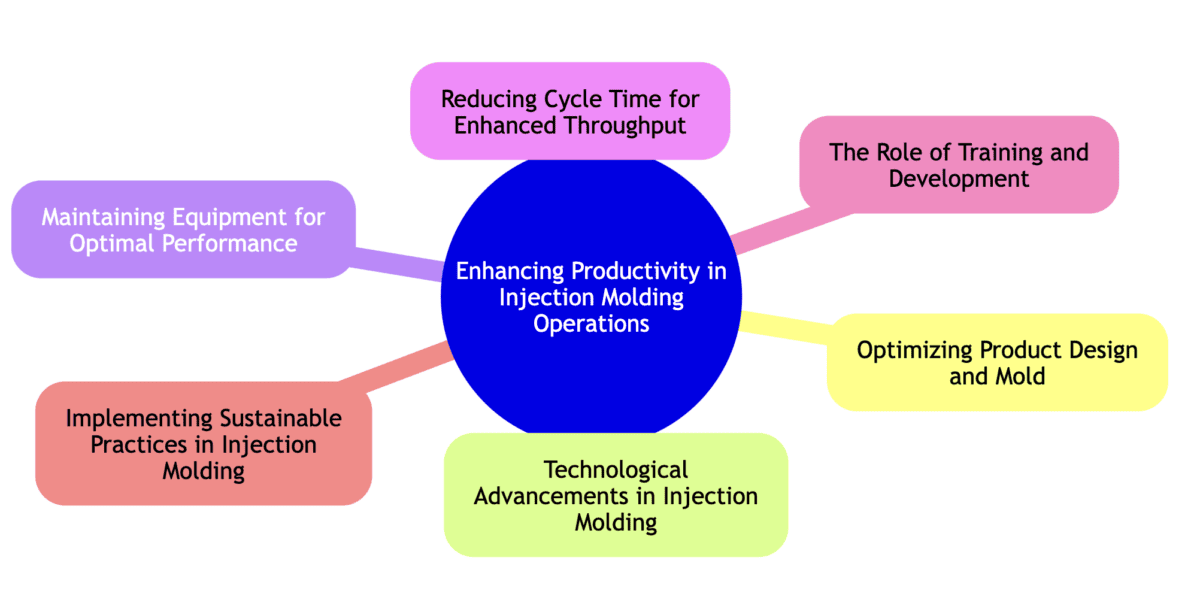Introduction – Enhancing Productivity in Injection Molding
Enhancing productivity in injection molding comes down to smart business structure and research.
We don’t always have to fail to learn. The internet is full of game-changing ideas for innovation and advancements. In this case, we recommend automation, investment in modernization, maintenance, and “lean practices.”
Continue reading to learn more about these principles.
Expert plastic injection molding company, JDI Plastics, presents this article laying out industry insights to help improve the injection molding industry.
Key Takeaways
- Streamline Design: Simplify products to minimize the use of resources and time.
- Modernize Molds: Invest in cutting-edge mold designs to reduce cycle times.
- Automate Processes: Integrate automation to reduce manual errors and speed up production.
- Regular Maintenance: Keep equipment in peak condition to avoid downtime.
- Lean Practices: Adopt lean manufacturing techniques to enhance efficiency and eliminate waste.

Optimizing Product and Mold Design
Optimizing the design of your products can significantly influence the overall efficiency of injection molding operations. By reducing the complexity and number of parts, you can minimize cycle times and use materials more efficiently. This not only speeds up the production process but also reduces waste and operational costs, providing a direct path to improved productivity.
- Reduces material waste: Efficient designs use less plastic, lowering raw material costs.
- Decreases production time: Simpler designs streamline the molding process, speeding up production.
- Enhances product quality: Uniform designs improve the consistency and quality of the final products.
- Lowers maintenance needs: Less complex molds are easier to maintain and less prone to wear and tear.
- Boosts profitability: Faster production and lower costs lead to better margins and increased profitability.
Technological Advancements in Injection Molding
Automation and Control Systems
Automation transforms injection molding by minimizing human error and ramping up production speeds. Modern control systems allow for precise adjustments in real-time, ensuring consistent quality and optimizing the use of materials and energy.
Advanced Materials and Techniques
Choosing suitable materials and employing innovative molding techniques are crucial for reducing cycle times and elevating product quality. Advanced materials can withstand higher pressures and dissipate heat more quickly, allowing for faster and more efficient molding cycles.
Implementing Lean Manufacturing
Lean manufacturing principles can revolutionize injection molding processes by eliminating waste and enhancing operational efficiency. Continuous improvement practices are key to achieving leaner operations, streamlining workflows and reducing excess labor and press time. (1)
Maintaining Equipment for Optimal Performance
Regular maintenance and calibration of injection molding machines and auxiliary equipment are vital to prevent downtime and ensure consistent product quality. Proactive upkeep helps avoid costly breakdowns and prolongs the life of the machinery.
Impact of Equipment Maintenance on Productivity
- Well-Maintained Equipment: Leads to higher efficiency, less downtime, and reduced repair costs.
- Poorly Maintained Equipment: Increases the likelihood of operational disruptions and higher production costs.
Reducing Cycle Time for Enhanced Throughput
Optimizing the injection molding process to reduce cycle time is essential for boosting throughput and enhancing productivity. Key strategies include refining cooling times, regulating material temperatures, and improving mold designs. These adjustments speed up the entire cycle and enhance the quality and consistency of the molded parts.
Techniques to Reduce Cycle Times
- Cooling Time Optimization: Implementing faster cooling techniques to minimize wait times.
- Material Temperature Control: Adjusting temperatures to optimal levels for quicker processing.
- Enhanced Mold Design: Innovating mold configurations for more efficient cycles.
The Role of Training and Development
Well-trained staff can dramatically enhance the efficiency of injection molding operations. Proper training ensures that workers are proficient in current technology and adaptable to new or upgraded systems and methods.
Top Training Techniques for Productivity
- Hands-on Machine Training: Practical experience on the machines.
- Simulation-Based Learning: Virtual reality and simulations to train without production interruptions.
- Continuous Improvement Programs: Regular updates and skill upgrades.
- Safety and Compliance Education: Ensuring all operations meet industry standards.
- Lean Manufacturing Workshops: Teaching principles of waste reduction and efficiency.
Implementing Sustainable Practices in Injection Molding
In the modern business landscape, sustainability is not just a buzzword but a necessary practice that can enhance both the environmental footprint and the profitability of manufacturing operations. In injection molding, implementing sustainable practices can lead to significant material savings, reduced waste, and improved brand image.
Key Areas for Sustainability in Injection Molding
- Material Recycling and Reuse: Promote the use of recycled plastics and the regrind from sprues and runners in the production process.
- Energy-Efficient Machinery: Upgrade to energy-efficient injection molding machines that consume less power and reduce greenhouse gas emissions.
- Biodegradable Materials: Encourage the use of biodegradable or bio-based plastics to reduce dependency on fossil fuels and enhance the end-of-life options for products.
- Process Optimization: Continuously optimize processes to reduce scrap rates and enhance material efficiency, minimizing the overall environmental impact.
Final Thoughts – Quality Injection Molding Service
This guide has outlined the pivotal strategies to turbocharge productivity in injection molding operations. Manufacturers can achieve superior efficiency and output by focusing on design optimization, technological upgrades, diligent maintenance, and robust training programs.
JDI Plastics is an example of quality and reliability in the injection molding industry.
Committed to continuous improvement and technological advancement, they ensure that your manufacturing needs are met with precision and expertise, solidifying their reputation as a trusted leader in the field.
Reference: Improve-Your-Injection-Molding, Lean Manufacturing Principles And Their Benefits, https://www.improve-your-injection-molding.com/lean-manufacturing-principles.html
